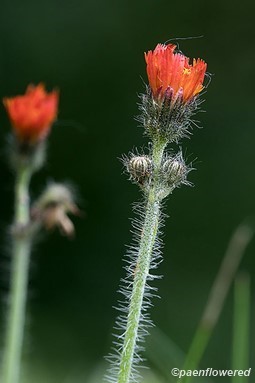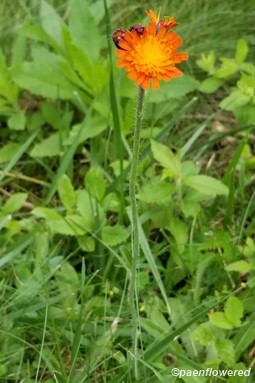Pilosella aurantiaca
A European hawkweed with bright orange flowers blooming all summer
Pilosella aurantiaca orange hawkweed
Add to MyPlants View Locations
This perennial member of the aster family is very similar to the yellow hawkweed or king devil (P. caespitosa) except for the color of its flower. It has the same hairy lance-shaped, basal leaves, leafless stalk with black hairs and a composite flower made only of ray florets. The color, however, is distinctive - a deep red-orange often fading to yellow in the center. The flower also reflects ultraviolet light that is visible to pollinators but not humans. Each ray flower has five tiny lobes at its tip. The anthers are positioned between each ray floret. The bracts behind the flowers are densely covered in glandular hairs. The color is the primary reason for one of the alternative names of this species - devil’s paintbrush.
The plant can have 2-25 flowers per terminal cluster. Each flower is 0.75 to 1 inch across. The juice of the plant is milky white. Like the king devil, this plant was introduced from alpine regions of central and southern Europe as a garden plant and has widely escaped cultivation. According to the U.S.D.A. orange hawkweed is found throughout Pennsylvania. It grows well along roadsides, in disturbed ground, and in fields and lawns.
This species does not seem as common as yellow hawkweed but is certainly not rare. In agricultural fields and in lawns it can easily become a weed and is difficult to eradicate. It is officially listed as a noxious weed in Colorado, Idaho, Montana, Oregon and Washington.
Orange hawkweed can reproduce by wind-dispersed seeds or asexually by stolon or rhizome. It can grow 8-24 inches tall but can be shorter where mowed. The name hawkweed came from the Roman naturalist Pliny who believed incorrectly that hawks ate the plant to improve their eyesight.
Habitat & Range
Frequently naturalized in abandoned fields, meadows, and pastures.
Present throughout the state, more common in the north.
Wetland code: Not classified
Phenology
Flowers June through September.
Pilosella aurantiaca orange hawkweed
Synonyms: Hieracium aurantiacumAdd to MyPlants View Locations






Comments
Have you spotted this plant in your area? We'd love to hear about your experience! Share your comments or questions about the plant below. Comments are moderated before posting.